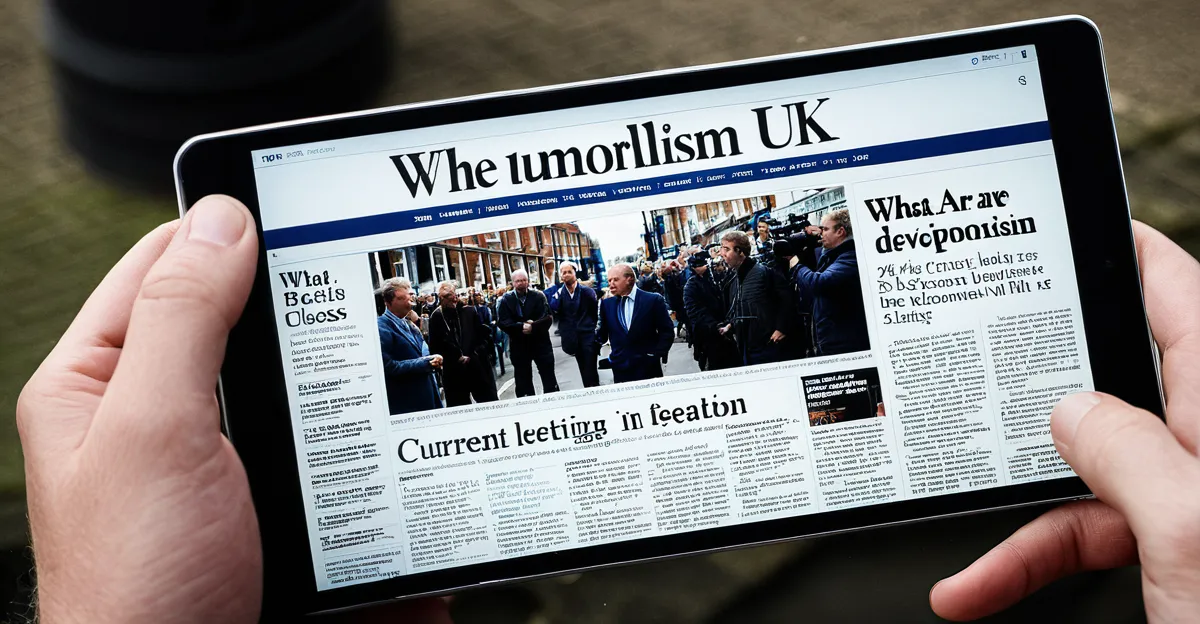Digital transformation shaping newsrooms
Technology in UK media has catalysed a profound shift towards digital journalism, guiding newsrooms to innovate at an unprecedented pace. This transformation prioritises digital-first strategies, which involve publishing stories primarily online and using new storytelling formats like interactive articles, video packages, and podcasts. Such formats enhance engagement and adapt to changing reader preferences.
Data journalism has surged as a critical element of newsroom innovation. By analysing and visualising complex datasets, journalists provide deeper context and clarity. Multimedia reporting—combining text, graphics, audio, and video—also enriches content and appeals to diverse audiences.
Also to discover : How Will Recent Political Changes Affect UK’s Trade Relations?
Artificial intelligence (AI) and automation have been integrated into news production to increase efficiency. Tools powered by AI can automate routine tasks such as transcription, data processing, or even headline generation, freeing reporters to focus on investigative work. This digital shift fosters more dynamic, accurate, and timely journalism, positioning UK media outlets at the forefront of newsroom innovation.
Growth of independent media outlets
Independent journalism UK has emerged as a vital force, providing diverse perspectives beyond traditional media. This growth stems from the rise of alternative news platforms, which prioritize community engagement and focus on specific interests or regions often overlooked by mainstream outlets. Media startups, particularly nonprofit journalism models, have flourished by adopting crowdfunding and membership schemes, creating sustainable revenue streams without heavy reliance on advertising.
This might interest you : What measures are being taken to combat homelessness in the UK?
Niche, community-led publications strengthen local reporting, offering tailored content that resonates deeply with their audiences. These outlets leverage digital tools to operate flexibly and efficiently, demonstrating the potential of technology in UK media to democratize access to information.
Diversification of revenue models is a key factor enabling independent outlets to thrive. Alongside subscriptions and donations, some explore partnerships and branded content to maintain editorial independence. This financial agility supports innovation, allowing these media startups to experiment with formats and storytelling techniques that enrich UK journalism.
As independent journalism UK expands, it fosters pluralism, strengthens democratic discourse, and complements the evolving digital journalism landscape within larger newsrooms.
Social media redefining news dissemination
Social media news has transformed news distribution UK by offering instant access and vast reach. Platforms like Twitter and Facebook enable rapid sharing of breaking stories, increasing engagement and allowing journalists to connect directly with audiences. However, this immediacy also presents challenges, including the spread of misinformation and the reinforcement of echo chambers where users encounter only like-minded views.
How do newsrooms address misinformation on social media? They increasingly collaborate with social platforms for content moderation, employing fact-checking and flagging systems to identify and reduce false information. These partnerships are vital in maintaining journalistic integrity while navigating the fast-paced social media environment.
Moreover, social media platforms have become essential spaces for journalism, providing tools for live reporting, audience feedback, and multimedia storytelling. This shift requires newsrooms to adapt workflows and embrace technology in UK media that supports real-time reporting and interactive content. Thus, social media redefines not only news distribution UK but reshapes journalistic practices to meet evolving digital demands.
Evolving audience trust and engagement
Understanding media trust UK is crucial as audiences become more selective in their news consumption patterns. Recent studies reveal a mixed landscape: while trust in mainstream outlets has wavered, alternative sources and independent journalism have gained credibility among specific demographics. How do news organisations rebuild trust? Transparency and rigorous fact-checking emerge as key strategies.
By openly correcting errors and providing clear sourcing, media outlets demonstrate accountability, fostering audience behaviour rooted in confidence. Moreover, personalisation and interactive features align news delivery with evolving news consumption patterns. Audiences now expect tailored content that resonates with their interests and real-time engagement opportunities such as comments, polls, or user-submitted stories.
This shift influences how newsrooms design content and engage readers. Incorporating user feedback and enabling two-way communication channels encourage active participation, strengthening community ties. Overall, adapting to these changing audience dynamics supports sustainable media models and reinforces the crucial relationship between trust, engagement, and quality journalism in the UK.
Regulating the changing media landscape
Regulation of UK media aims to uphold press standards while balancing government policy and journalism freedoms. Recent updates to press regulation seek to strengthen oversight mechanisms that ensure accountability, accuracy, and ethical reporting. These reforms respond to evolving challenges from digital platforms and changing news consumption patterns.
How does UK media regulation address disinformation? Government initiatives focus on combating online harms by introducing stricter rules on misinformation distribution and enhancing cooperation between regulators, platforms, and news organisations. This coordinated approach aims to protect audiences without infringing on journalistic independence.
Ongoing debates center on maintaining freedom of the press amidst increasing calls for oversight. Critics warn that overregulation could stifle investigative journalism, while proponents argue that clear standards foster media trust UK and public confidence. Ultimately, regulatory frameworks continue evolving to navigate the intersection of technology, governance, and editorial autonomy, ensuring that journalism in the UK remains robust and responsible in a complex digital era.






